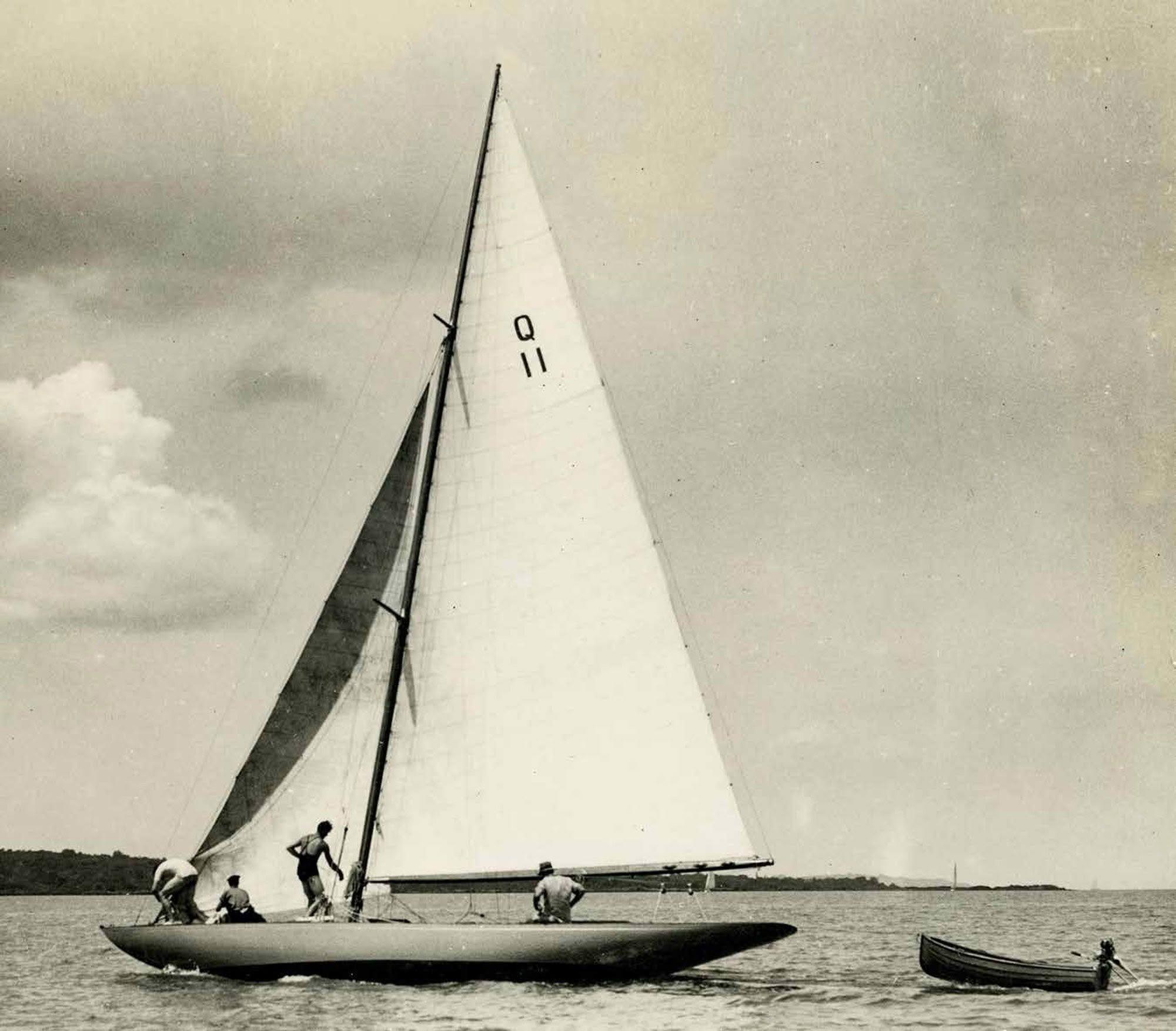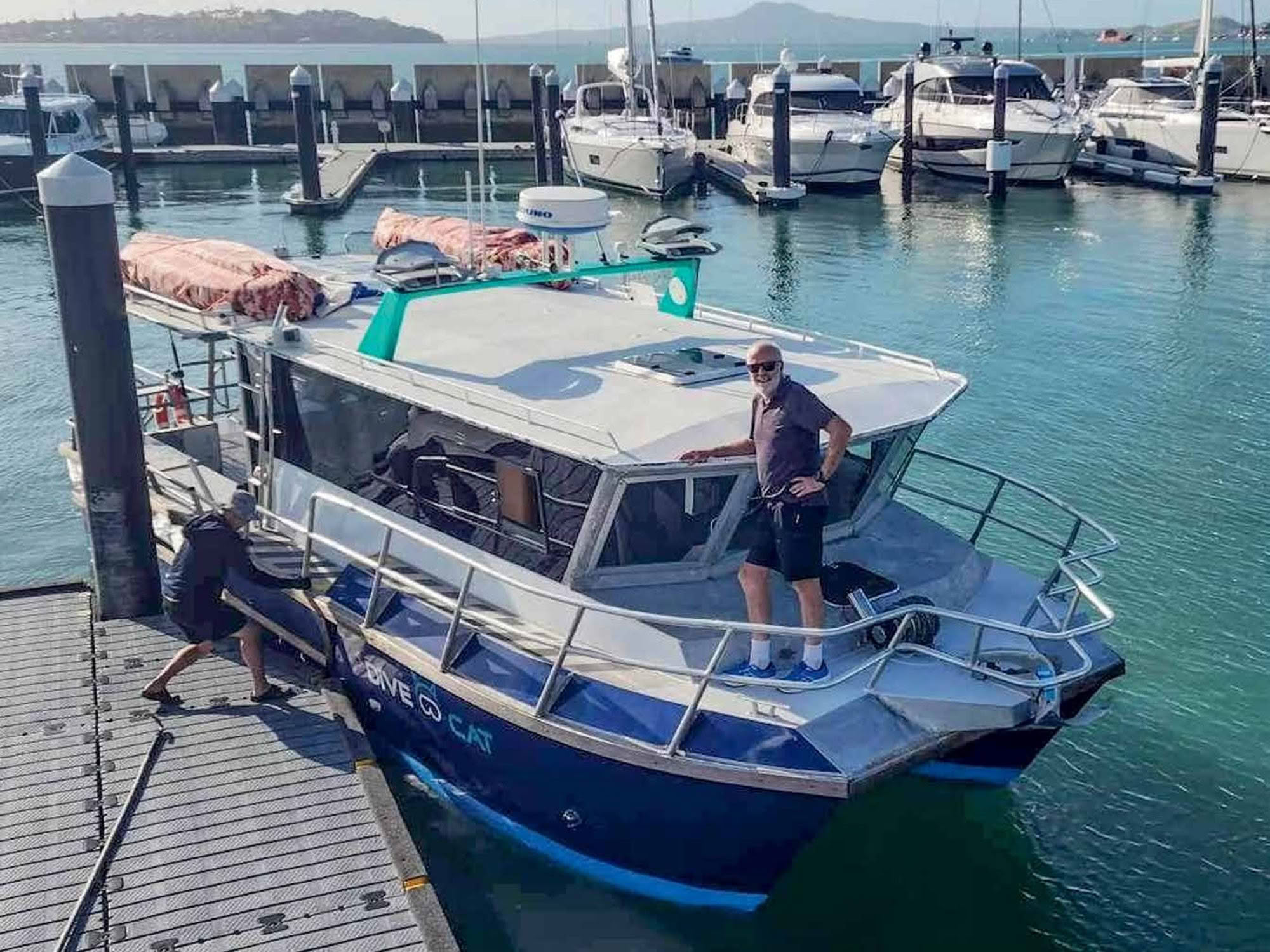

In December 1928 Guy and Noel Tattersfield were well pleased with their new purchase, the 32ft keel yacht Janet.
Her Tauranga owners, the Simmonds brothers, had already converted her original gaff cutter rig to the more efficient high (for the time) aspect ratio marconi or bermudan sloop rig (see Sidebar) with a shortened bowsprit.
The Simmonds brothers did the rig conversion in Tauranga in November 1927 to take part in the 1927 Auckland-Tauranga race in the December. They were undoubtedly influenced by the performance of the new Colin Wild-designed-and-built bermudan Auckland keel yacht Nga Toa in the 1926 race when she took line honours in a full easterly gale.
Guy and Noel Tattersfield sailed as crew in the 1928 Auckland-Tauranga race in Iorangi and Celox respectively. They then took over Janet and sailed her back to Auckland. Their crew was Guy, Noel, Leo, their 18-year-old brother, P. Simmonds and J. Meers. All of the six Tattersfield brothers enjoyed their racing and cruising in Janet, racing mainly with the Squadron and Akarana Yacht Club – “a welcome addition to Class C” said the Herald. For just under seven years, until they succumbed to the glamour of Lt Home Kidston’s Altair in late 1935, they worked Janet up to being competitive in harbour races and a handicap menace in the Tauranga Race.

The brothers had bought Janet because they were attracted to offshore racing. Their first race of this type was the AucklandRussell race of December 1929 which was sent away from King’s Wharf 15 minutes after the entrants in the Tauranga race into a dying SW breeze. Janet was the smallest boat in the race, on a long handicap of five hours 15 minutes to the scratch boats Ariki and Thelma.
A year later, in December 1930, the Tattersfields went south in the 121-mile Auckland-Tauranga race alongside the crack C Class yachts Wairiki (Dane Macky) and Queenie (Tom Hill). Janet’s crew were Noel and Leo Tattersfield, N. Somerville, J. Stewart and E. Harrop. Janet came in some hours after the rest of the fleet including the 1904 Bill Oliver-built Iris (C8). In the keel yacht race at Mount Maunganui on Boxing Day Janet also trailed the field just behind her old adversary Matua.
In March 1931 Janet broke her mast in the Squadron race to Te Kouma. “The yacht was running before a steady breeze with her spinnaker set, and when about two miles outside of Waiheke, the mast snapped near the deck,” said the Herald. In December of 1931 the Tattersfields went back to the Tauranga Race, being joined by Ted Hay’s Scout (C2). On four hours handicap from Iorangi, Janet got a good third, skippered by Leo Tattersfield, followed by a second in the yacht race on Boxing Day in Tauranga.

Noel Tattersfield had now qualified as a solicitor and eldest brother Guy was now Managing Director of bedding manufacturers Tattersfields Ltd. He was increasingly occupied with keeping the business going and keeping the staff during the trading challenges of the Great Depression which was now biting severely. Nevertheless, during the 1932-3 season, Janet always had a strong crew of Guy’s younger brothers. Aside from harbour racing, Janet took part in the Squadron’s Governor General’s Cup and its Te Kouma race in March 1932, plus the Tauranga race in the December. This year, sailed again by Leo Tattersfield, Janet got out amongst the leaders and came in fourth on line after heavy seas, rain and a strong NE off the Watchman. She won the Second Class Yacht race on Boxing Day.
Janet was back again for the Tauranga race in December 1933, skippered by Noel Tattersfield and crewed by his younger brother Felix, K. Stewart, D. Colebrook and D. Lloyd. Her Sutherland-built stablemate Waione won on line and handicap, beating Nga Toa in by one second! Janet got a second on handicap. In the Boxing Day race Janet got stuck in mud four times. Leaving Tauranga, the weather was heavy, but Janet had a glorious sail “like a half-tide rock” back to Whitianga under trysail and storm jib and then on home in kinder weather.
In 1934 the same pattern was repeated; the Squadron and Akarana harbour races, the Te Kouma race, the Devonport YC and Akarana races to Matiatia and Awaroa Bay, the Easter cruise to Kawau, but not the Tauranga race in December.

On December 8, 1934 Noel Tattersfield had presented himself at Queen’s Wharf to Georg Dibbern, the skipper of the ketch Te Rapunga, and suggested that he be taken on as crew on the Trans-Tasman race to Melbourne which was about to start at 2.30pm that day. Dibbern knew Noel from Akarana YC connections and respected his ability. He knew too that one of his crew, the journalist Austin Vaile, was totally inexperienced. Noel would make up a useful watchkeeper with the rest aboard, his nephew Gunter Schramm who had sailed with him from Germany, and Fred Norris of Devonport, a highly experienced local yachtsman. Noel was welcomed aboard, virtually as he stood up.
The race had attracted interest from 12 potential entrants but Te Rapunga and Johnny Wray’s cutter Ngataki were the only two to start that morning. The two yachts soon lost contact running up the east coast of Northland. Te Rapunga was leaking badly. She had spent too much time on the hard and had opened up. Dibbern elected to pull her up at Russell for recaulking. After a long period of fine weather in the Tasman, they were first to arrive at the Heads at Port Phillip Bay, 19 days out of Auckland into the midst of an immense regatta to celebrate Victoria’s centenary.
Te Rapunga found a warm welcome moored at the St Kilda Yacht Club where she was joined by the Ngataki crew 33 hours later. The Aussie hospitality was almost overwhelming for many days and nights. Then the Tasmanian authorities knitted up a race for the two yachts to arrive in time for the Hobart Regatta with a prize of £20 to the winner, £10 for second. Fred Norris had returned to Auckland. Dibbern replaced him with Betty Roehr, the wife of a friend who ran a restaurant in Melbourne, not a popular decision with the crew.

The start of the race was hilarious. The rules were simple. In South Sea Vagabonds Johnny Wray describes the start.
“The crews of the competing yachts should be assembled at the bar of the Royal St. Kilda Yacht Club on the 23rd. The starting gun would be fired at 7pm and the crews would consume a schooner of beer (one imperial pint) as rapidly as possible. They would then run down the road and along the wharf and get under way.”
The starting gun goes off. Georg Dibbern in his book Quest takes up the tale.
“Johnny immediately gets hold of his boys by the scruff of the neck, prods them down the staircase, and soon they can be seen tearing along the long pier, which is black with people. Not so my little lambs. They are leaning out the window to watch, and almost kill themselves laughing. Expectantly the people on the pier await our quick appearance. Vainly do I beg and scorn and try to persuade.”
Ngataki shot away but pulled up short as the stern anchor was still out, possibly not by accident. Finally, Georg managed to persuade Noel and Austin Vaile from the bar, leaving only his nephew, ship’s mate Gunther Schramm, behind, protesting he needed to pump ship. Georg became uncharacteristically angry and set the crew about hoisting sail and securing the dinghy. Then came a loud cheer from the crowd as Gunter came sprinting along the pier “handicapped by a large sack containing bottled liquids usually included in a yacht’s stores.”

Once aboard, Gunter was heaving on the topping lift when he was hurled overboard by the mainsheet but was quickly fished out. His antics were again loudly cheered by the crowd. Gunter waved back cheerily but was sent below out of harm’s way to sleep it off.
A NW gale hammered the two yachts. Ngataki got in three and a half days after Te Rapunga to another huge Aussie welcome. The yachts took part in a special race at the regatta “for overseas yachts”. Ngataki won the first prize of £20. The crew stayed for sightseeing and enjoyed some massive Tassie hospitality. It became the end of February. Noel Tattersfield was keen to get back to Auckland.
The return trip made Bluff the first port, for the oysters, it seems, then up to Napier. By now Noel was determined to get back to Auckland. He had become engaged to Janet Wallace before he left. Dibbern took on a girl crew member at Napier for the short trip to Gisborne where he decided to stay for a week. Not unreasonably, Noel had had enough, and left for Auckland. His parents were about to go overseas and his fiancée no doubt was making her feelings known. But he was always grateful to Dibbern for the privilege of taking part in such an iconic voyage.
Tony Stevenson tells me that the Tino Rawa Trust is in the process of bringing Ngataki back to her 1935 gaff rig. Te Rapunga is now being restored in Australia. Tony is confident that the start of the 1935 Melbourne-Hobart race will be rerun in February 2025 at the Royal St. Kilda Yacht Club, Ngataki v. Te Rapunga, 90 years on. Now that’s worth a trip to see! BNZ


MARCONI RIG
The term ‘Marconi’ was a reference to the tall wire-braced radio masts of Signor Marconi, then a new wonder of the world, while ‘Bermudan’ referred to the triangular ‘leg of mutton’ sails on the fast sloops of Bermuda. In 1917 William Gardner designed the bermudan sloop Varuna for the Commodore of the New York Larchmont Yacht Club. The triangular mainsail, with its superior performance to windward, became accepted state of the art. Manfred Curry followed up with his scientific findings in 1925 in his book Yacht Racing, the Aerodynamics of Sails and Racing Tactics.
In Auckland, Arch Logan, always up to date with yachting innovations, had led the way from 1919 with his centre-boarders Sea Urchin, Secret, Surprise and the twin M Class patikis Mawhiti and Matarere. His disciple Colin Wild set the seal of approval on the rig with his six-metre Delville (now Kotuku) in late 1922 and the 47-footer Nga Toa for the Winstone brothers in late 1926.
While Janet succumbed early to the move to the marconi rig, a great many of her local contemporaries remained under gaff rig for years, some, like Ariki, until today, for the gaff rig has many virtues, including greater power when running…plus its high nostalgia factor.




